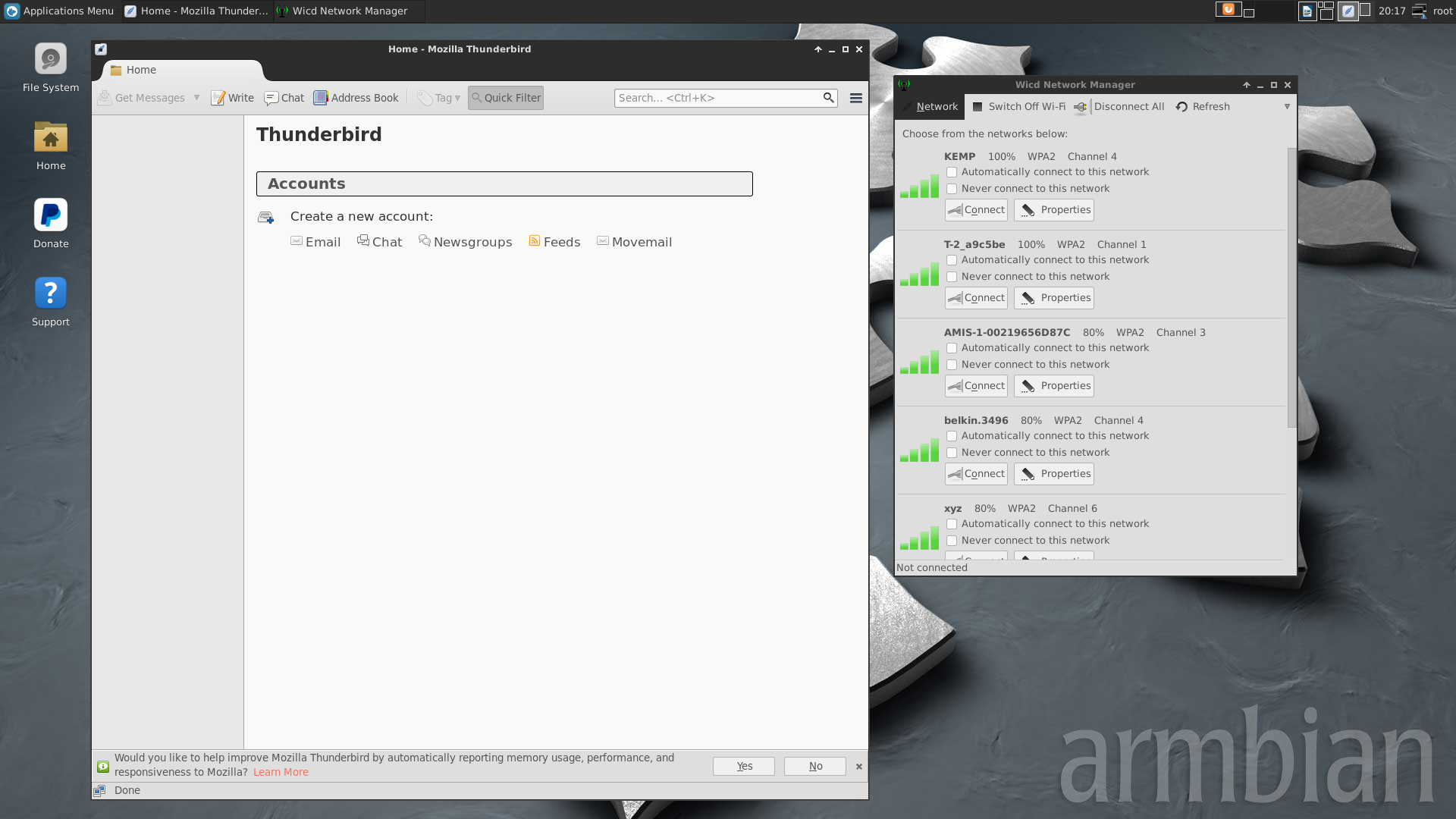Install Mplayer Debian Wheezy Raspberry
Hi All, Followed the following steps and i had media playback on Raspbian “wheezy” $sudo apt-get update $sudo apt-get install mplayer mplayer-gui alsa-base alsa-utils pulseaudio mpg123 $sudo reboot. Getting Sound and Video to Work on Raspberry Pi Top 10 Linux MP3 Players » Lindesk.
The LWN.net Linux Distribution List You have found the LWN.net Linux Distributions List. LWN has been tracking Linux distributions since 1999. Early versions of the list consisted of links on the side bars of the weekly Distribution page. By 2001 the list had grown to fill both sidebars of the weekly page, often trailing far below any actual mid-page content. So the list was moved to a flat file and released on October 11, 2001. The next major release was on February 7, 2002.


Install Mplayer Debian Wheezy Raspberry Pi

Additional information was added to each entry, and in the process links were fixed, entries moved to different categories and dead distributions were removed. Minor revisions have been made almost every week since then.
Debian with Raspberry Pi Desktop is the Foundation’s operating system for PC and Mac. You can create a live disc, run it in a virtual machine, or even install it on. Raspberry Pi 3. 08 Audio Controller. 00 Standard Microsystems Corp. Fast Ethernet Adapter. Standard Microsystems Corp. Linux Foundation 2.
A table of contents was added on May 9, 2002. There have been no major releases since then, however new distributions are added when found, dead distributions are removed when found, and link checking remains an ongoing process.
Someday this list will hopefully move to a searchable database, making it easier than ever to find what you are looking for. In the meantime, we hope you will enjoy this celebration of Linux diversity, with over 500 distributions; large and small, specialized and generalized, old and new. Table of Contents.
I have finally finished my last exams, so now I have more time to focus on some of my own projects. It has been a while since our was successfully funded, but we are still working on making the experience better for the final users. After the campaign ended we sent out a survey to all our backers with several questions about there address, profession and so on, but we also asked them if they had any suggestions for improvements or extra features they would like to see added to the Balanduino. A lot of people asked if we could enable wireless streaming for it.
I was personally very excited about that since I have been playing with the thought for quite a while, so when the for the Raspberry Pi became available I bought it straight away. If you do not have much experience with the Raspberry Pi I recommend reading Thomas’s blog post he wrote a while ago: and also to viset the official homepage:. I really have not used my Raspberry Pi that much – it has been laying on my desk for quite some time, as I did not have any real use for it until now.
I have tried some different approaches, but ended up using a something called. Note that there is currently no official binaries for Windows, so you will have to compile them yourself, but it works great on both Mac OS X and Linux. I am running Arch Linux on my Raspberry Pi since I do not need the desktop environment that comes with the official Raspbian “wheezy” image, but it should not make much of a difference.
I will not go into much detail on how to install gstreamer 1.0 on your computer, but instead I will refer to the page I originally got the commands from:. Also check out the original forum post:.
Video To stream video from my Raspberry Pi I run the following command. Bus 001 Device 002: ID 0424: 9512 Standard Microsystems Corp. LAN9500 Ethernet 10 / 100 Adapter / SMSC9512 / 9514 Hub Bus 001 Device 001: ID 1d6b:0002 Linux Foundation 2.0 root hub Bus 001 Device 003: ID 0424:ec00 Standard Microsystems Corp. SMSC9512 / 9514 Fast Ethernet Adapter Bus 001 Device 004: ID 0d8c:000c C-Media Electronics, Inc. Audio Adapter Note the last device is my USB sound card.
Btw I recommend using ssh to login to your device. In fact I never use the HDMI output, as I prefer using my laptop. For more information check out this guide by Adafruit:. If your audio device is not working properly, then I recommend googling your USB sound card, as somebody else have properly already written a guide on how to get it working. After that you will need to install the following packages: ‘alsa-utils’, ‘alsa-firmware’, and ‘alsa-plugins’. Since I run Arch Linux I do this by running. Gst-launch- 1.0 -v udpsrc port= 5001 caps= 'application/x-rtp'!
Autoaudiosink sync= false If you experience dropouts you might want to add ‘num-buffers=1000’ just after ‘device=plughw:Set’ at the server side, but in my experience it actually works better by not using it. In the end I decided to create two scripts. One at the streaming end (the Raspberry Pi) and another and the receiver – my computer. This will allow me to stream the video and audio simultaneously from the Raspberry Pi to my computer. The streaming script.
Hi, thank you very much for the bash scripts. I tried them out, they work very well. But could you could help me?
I’m trying to adjust your code for streaming video (rPi Camera module) and Audio (USB soundcard – hw:1,0) to utream or another of the online services. I tried ffmpeg and the delay is just too much and I can’t sync the audio, it moves in and out an in the end just lags behind more and more. So I looked at gstreamer and came across your post. Is there any advice you could give me? I have tried using GUI VLC open network stream (Pi IP Addr is 192.168.0.136):- rtmp://192.168.0.136:5000 tcp://192.168.0.136:5000 rtp://192.168.0.136:5000 The script running at Pi is:- raspivid -t 999999 -h 720 -w 1080 -fps 25 -hf -b 2000000 -o – gst-launch-1.0 -v fdsrc! Rtph264pay config-interval=1 pt=96!
Tcpserversink host=192.168.0.136 port=5000 There is error message display on VLC:- Your input can’t be opened: The network connection from my PC where VLC is running to the Pi is fine Any idea is it the parameter given to VLC is wrong? I have tried your code but i have error. —————————————-error mesages——————————– pi@raspberrypi:$ gst-launch-1.0 -v alsasrc device=plughw:1! Udpsink host=192.168.10.255 port=5001 Setting pipeline to PAUSED ERROR: Pipeline doesn’t want to pause.
ERROR: from element /GstPipeline:pipeline0/GstUDPSink:udpsink0: GStreamer encountered a general resource error. Additional debug info: gstmultiudpsink.c(959): gstmultiudpsinkstart : /GstPipeline:pipeline0/GstUDPSink:udpsink0: Failed to bind socket: Unable to create socket: Address family not supported by protocol Setting pipeline to NULL Freeing pipeline —————————–end—————————— Please Help me. Hey Lauszus, I used these instructions about a year ago and they worked without a hitch! Well for a linux noob like me it took some tinkering (and i was using Debian not Arch) but I got my audio streaming! I decided to revisit this project but things really aren’t working this time. Doing sudo apt-get install alsa-firmware alsa-plugins just gives back: E: Unable to locate package alsa-firmware E: Unable to locate package alsa-plugins And asoundconf returns: asoundconf: command not found Some initial googling makes it seem like it’s deprecated or not in use anymore for Pulse?
Anyway I’d really appreciate any guidance you can give. I really can’t seem to find anyone else or guides that provide latency free audio streaming.
